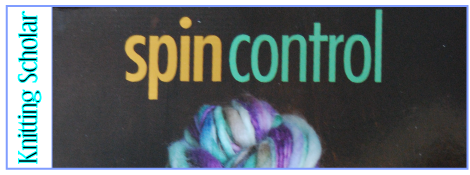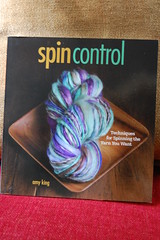First, the facts:
Title: Spin Control: Techniques for Spinning the Yarn You Want
Author: Amy King
Published by: Interweave Press, 2009
Pages: 119
Type: Spinning.
Chapters:
Spinning Techniques
Know Your Fiber
Work with Your Wheel
Measuring Success
Let’s Make Some Yarns!
Spectacular Singles
Two-ply: Spinner’s Yarn
Three (or More) Plies
Core spinning and More
Novelty Yarns
Pattern Size Range: N/A
The In-Depth Look:
This book has been sitting next to the computer for days now, waiting for me to review it, and I have no idea what’s been holding me back, because it’s a great book.
I’m so thrilled to see some intermediate-level spinning books coming out, and just like The Intentional Spinner, this one does a great job of explaining how to refine your spinning technique.
The book is broken into two, basic parts.
The first is “Spinning Techniques,” which starts with a description of different types of fiber, their properties, the ways they can be prepared to spin, and the ever-popular woolen-vs-worsted explanation. (Seriously, I’ve read this in just about every spinning book I have, and every author has a slightly different take on the subject, which I find fascinating.)
She also discusses the parts and engineering of a spinning wheel, and what the ratios are, how they work, and why you should care. The explanation of long-draw drafting, short-draw drafting and everything-in-between drafting is fabulous. I appreciated the section on how to fix mistakes while plying, too–that’s something I don’t think I’ve seen covered before but, well, sometimes singles DO break when plying!
The section on how to measure, analyze, and record data on your spinning is particularly interesting. It’s true–and she says it herself–that nothing will improve your spinning as much as hours spent spinning, but it’s also true that if you want to truly control your spinning, you need to be able to think about it. The angle of your twist, wraps-per-inch, the difference between “finished” and “unfinished” yarn. How else can you duplicate, exactly, a skein you’ve just made–whether it’s ten minutes from now or ten months from now? The explanation on how to analyze a yarn (handspun or commercial) with an eye to recreating it is wonderful.
The second half of the book is devoted to spinning specific kinds of yarns, starting with singles–because there is a definite trick to spinning singles that are strong enough to stand on their own as yarn. Basic, two-ply yarn is analyzed, too, with as clear a description of Andean plying as I’ve seen, and from there, she looks at other plied yarns (including cabled yarn). The last section explores how to make the novelty yarns. Boucle, for example, or yarn spun with add-ins like beads or feathers.
Overall, this book has a huge amount of useful, accessible information. The photos are beautiful to look at, and the instructional ones (as opposed to the purely decorative ones) are clear and easy to decipher–which is a must for a book describing a craft that is all about motion. The writing is clear and straight-forward, and it’s got lots of really good information.
This excellent book is available at Amazon.com.
Want to see bigger pictures? Click here.

This review copy was kindly donated by Interweave Press. Thank you!



Comments on this entry are closed.